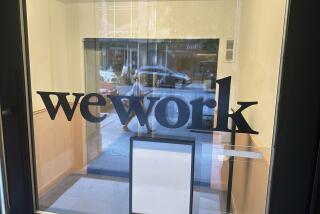Top lender files bankruptcy, lays off 3,200
- Share via
Irvine lender New Century Financial Corp. proved the old adage Monday: The bigger they are, the harder they fall.
New Century was once the largest independent company specializing in sub-prime mortgages for borrowers considered high credit risks. On Monday, it became the largest sub-prime lender to file for bankruptcy protection, firing 3,200 workers and saying it would aim to sell its remaining operations.
“It is our hope that potential buyers will be in a stronger position than we are to employ many of our associates on an ongoing basis,” Chief Executive Brad A. Morrice said in a statement.
The bankruptcy filing and layoffs of more than half of New Century’s workforce is the latest sign of a larger sub-prime shakeout, triggered by a sharp rise in loan delinquencies. More than two dozen lenders have closed, been sold or forced to cease sub-prime operations.
Will Spires is among the laid-off New Century workers. As he sees it, he’s not just leaving a company -- he’s leaving an industry. He plans to look for work as a salesman or finance manager at a car dealership.
“We made decent money” selling New Century loans, said Spires, who was an account manager in Houston. “But people are still buying cars. The car dealers are still in business, and New Century is not.”
Work throughout the sector is drying up. Many sub-prime borrowers obtained loans with no down payments and with low introductory teaser rates -- often without having to prove their income -- hoping to refinance before their payments shot up.
But as lenders tighten standards amid rising defaults and weakening home prices, many of these borrowers won’t qualify for new loans.
Countrywide Financial Corp. in Calabasas, the No. 1 mortgage lender, has estimated that 60% of its sub-prime customers have adjustable-rate loans that they would be unable to obtain under guidelines proposed by federal bank regulators, said analyst Zach Gast of the Center for Financial Research and Analysis in Rockville, Md., which advises big investors such as hedge funds.
Gast said that when the industry stabilized, it would be dominated by large commercial and investment banks such as Wells Fargo & Co. of San Francisco and London-based HSBC, the No. 1 sub-prime lender in the U.S. last year. For these banks, sub-prime lending is just one facet of their business.
New Century, by comparison, had all its eggs in the sub-prime basket.
The 12-year-old company weathered the last big shakeout in the industry during the late 1990s, then grew “gigantic -- and arrogant too, cocky,” said analyst Matthew Howlett at investment firm Fox-Pitt, Kelton.
Morrice and co-founders Robert K. Cole and Edward F. Gotschall made tens of millions of dollars each in salary, bonuses and stock options. Striving to take its image mainstream, New Century adopted the slogan “A New Shade of Blue Chip.”
But its loans performed no better than average for a sub-prime lender, Howlett said. And its operational safeguards, such as guarding against inaccurate appraisals and accounting for losses, appear to have been inadequate, he said.
“It just seems like the whole operation was fast and loose, and it finally caught up with them,” Howlett said.
Independent sub-prime companies generally sell their loans to Wall Street firms, which can force the lenders to buy back mortgages that go quickly into default. New Century stunned investors and triggered its eventual downfall Feb. 7, when it announced it had grossly underestimated the losses it would suffer as a result of numerous loan repurchase demands.
It was hit almost immediately by a wave of shareholder lawsuits contending that its top executives had made millions exercising stock options while concealing the company’s troubles.
The company then disclosed that it was under investigation by federal prosecutors and the Securities and Exchange Commission for its accounting practices and executives’ stock sales.
The filing for Chapter 11 bankruptcy protection, made in federal court in Wilmington, Del., had been anticipated since March 9, when New Century stopped lending after its Wall Street partners cut off its funding.
More recently, at least two of the firms, Barclays and Morgan Stanley, had moved to seize and sell pools of its mortgages to satisfy their claims against the mortgage lender.
The layoffs announced Monday made up 54% of the company’s staff and came mainly at New Century’s shuttered loan-origination arm, for which no buyer had emerged.
Carrington Capital Management, a Connecticut hedge fund, has agreed to pay $139 million for a separate operation with about 550 employees. The servicing unit bills borrowers and collects payments, the company said.
New Century’s remaining interests in loans, its only other significant asset, will be sold for a net gain of $50 million, Morrice said.
As with home sales, the sub-prime loan business has become a buyer’s market.
H&R; Block’s sale of its Irvine-based Option One Mortgage, the ninth-largest sub-prime lender last year, has been delayed by what the company referred to Friday as “recent events in the mortgage industry.”
Many analysts believe that Option One will command only a fraction of the $1.3-billion sale price Block had been predicting since November.
Regions Financial Corp., a Birmingham, Ala., bank that in January announced a $225-million sale of its sub-prime unit, EquiFirst, is an example of how prices have declined. Regions said Monday that EquiFirst -- the 18th-largest sub-prime lender in 2006 -- ended up selling for just $76 million because of operating losses.
New Century said that to work its way through the bankruptcy proceedings, the company would have to spend an estimated $150 million.
It has arranged to borrow as much as that from CIT Group Inc., a New York-based finance company, and the Royal Bank of Scotland’s Greenwich Capital unit, which handles sub-prime investments in the United States.
The net gain of $39 million left after the borrowing and asset sales presumably will be wiped out by losses on the future sale of $8.4 billion in loans that New Century was obligated to buy back from its Wall Street partners, Gast said.
Pools of sub-prime loans have been selling for just 94 to 98 cents for every dollar of face value, he noted.
“It doesn’t look like there’s going to be anything at all left for the stockholders,” Gast said.
New Century shares, which reached an all-time high of $65.95 in December 2004, fell 14 cents to 92 cents Monday in over-the-counter trading.
*
(BEGIN TEXT OF INFOBOX)
Tips for borrowers
Borrowers with New Century mortgages should continue making their payments as scheduled, despite the company’s filing for bankruptcy protection, the company advised Monday.
For more information, customers can call New Century at (800) 561-4567 or visit its website at www.ncen.com.
Borrowers who anticipate problems making loan payments should talk to the company as soon as possible to explore alternatives, New Century said.
--
Source: Times research
Los Angeles Times
More to Read
Inside the business of entertainment
The Wide Shot brings you news, analysis and insights on everything from streaming wars to production — and what it all means for the future.
You may occasionally receive promotional content from the Los Angeles Times.











